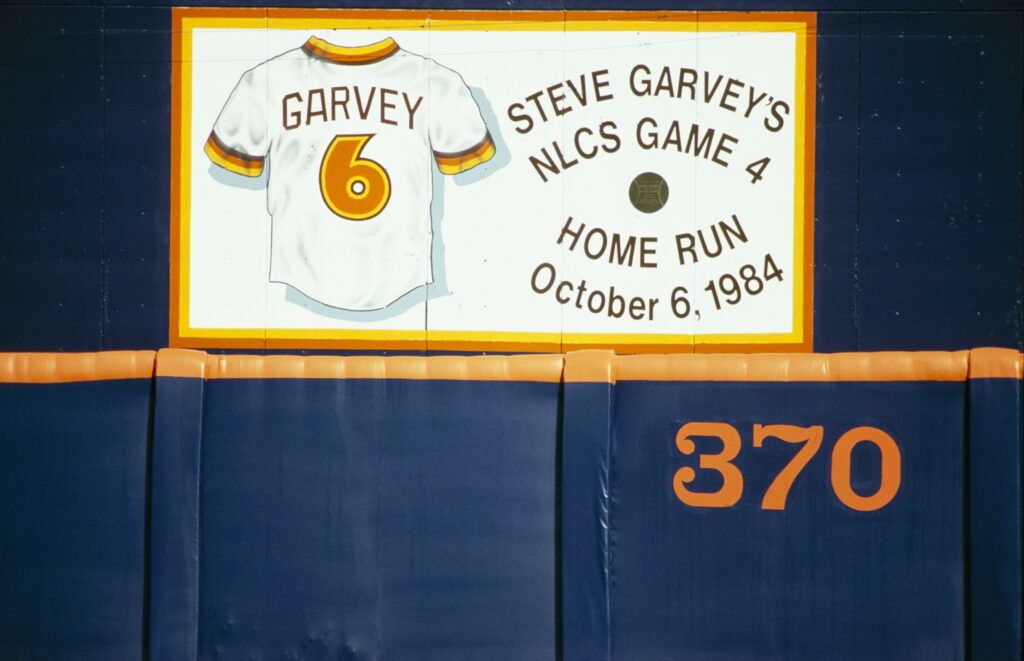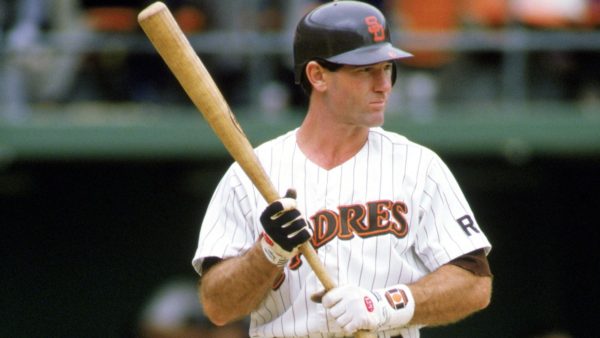Revisiting Steve Garvey’s tenure with Padres and his retired number

(Photo by: Stephen Dunn/Getty Images

Let’s take a look at Steve Garvey and his time with the San Diego Padres.
On a late afternoon on October 6, 1984, Padre fans erupted in Jack Murphy Stadium and in neighborhoods all over San Diego County when first baseman Steve Garvey hit one of the most memorable home runs in the history of the organization.
For the first time since the birth of the Padres in 1969, the team had made it to the playoffs. Cub-Busters t-shirts showed up all over the county. Facing elimination, Garvey’s home run propelled the team on to Game 5 of the National League Championship Series.
The series began in Chicago against the Cubs, and the Padres lost the first two games 13-0 and 4-2. So when the Padres returned to San Diego the team faced elimination. With their backs against the wall, the Padres won Game 3 by a decisive 7-1 score beating Dennis Eckersley in front of what reliever Goose Gossage called the loudest crowd he’d ever heard.
In the 9th inning of Game 4, Garvey hit the shot heard around the county off of closer Lee Smith. The Padres had scored first going ahead 2-0, but the Cubs answered with three runs and led the game until the Padres tied the score in the bottom of the fifth and went ahead 5-3 in the seventh. Again the Cubs answered and the seesaw game went into the ninth inning tied 5-5. Alan Wiggins struck out swinging, but Tony Gwynn hit a single. Up came Steve Garvey who belted a ball over the center/right-field wall. Both Gwynn and Garvey touched home plate as fans in the Murph and in front of their televisions went berserk as the Padres won the National League pennant and went on to their first World Series.
Unfortunately, the Padres faced a juggernaut in the Detroit Tigers. The team had a 104-58 record and featured future Hall-of-Famers pitcher Jack Morris and shortstop Alan Trammel. On October 9 at home, the Padres played their first World Series game losing 3-2. But San Diego won Game 2 5-3. The series moved to Tiger Stadium, and the home team ultimately prevailed with scores of 5-2, 4-2, and 8-4.
Of course, the loss to the Tigers hurt. But, for the first time in the history of the organization, the San Diego Padres proved they belonged in the big leagues. The year before, the team had broken even at 81-81, but in 1984 made a considerable leap to win 92 games. Of course, back then, the path to the ultimate prize had fewer obstacles. The Padres had to face only one team, the Chicago Cubs, in the National League Championship Series to make it to the World Series.
No-nonsense Dick Williams managed the team, and Tony Gwynn, in his third year in the big leagues, won the batting title. That season also featured an all-out brawl with the Atlanta Braves in which multiple pitchers threw at or hit batters, dugouts cleared, and mayhem ensued.
In December 1982, general manager Jack McKeon (aka Trader Jack) outbid the Los Angeles Dodgers and offered Steve Garvey a $6.6 million deal he couldn’t refuse. At the time, McKeon emphasized Garvey’s importance as a role model for the younger players on the roster. Ironically, history repeated itself in February 2018, when current GM A.J. Preller signed another first baseman, Eric Hosmer, to be a leader in another young clubhouse. Of course, that $144 million deal makes Garvey’s contract look like chump change.
Drafted by the Dodgers in 1968 in the first round, Garvey made the big league team in September the following year. Although he played sporadically (mostly at third base) his first four years, he found a permanent home at first when Wes Parker retired. Garvey spent 14 seasons in Los Angeles, making multiple All-Star appearances and being named NLCS MVP in 1978.
In 1984, Garvey made history by becoming the only first baseman to commit no errors in a season. He ended his career in 1987 after playing for 19 years. On April 16, the following year, the Padres officially retired his number 6 in a ceremony at Jack Murphy Stadium, the first number to be retired in the franchise’s history at that point.
Whether that number 6 belongs up there with other the retired numbers of Mr. Padre Tony Gwynn, Dave Winfield, Randy Jones, and Trevor Hoffman (as well as Jackie Robinson’s 42) has been debated through the years. Longtime San Diego Union-Tribune sportswriter Bill Center counts himself as one of those who answer with a resounding no, but he would prefer actually to rip it down.
Yes, that home run helped turn around the division championship series and gave the Padres a shot of actual relevance. However, the preponderance of opinion nixes the decision to retire Garvey’s number for a variety of reasons:
- One home run shouldn’t be the standard for retiring a number.
- Steve Garvey was a Dodger masquerading in a Padre uniform. He helped the Dodgers to a World Series championship in 1981 and played in Los Angeles for 14 years. By the time he came south, his best years were behind him.
- Selecting Garvey’s number to be the first to receive that honor insults players like Randy Jones who came before him.
- Garvey is just one example of the stars, like Fernando Valenzuela and Greg Maddox, who arrived in San Diego in the twilight rather than the prime of their careers.
Hindsight being 20-20, the Padres should have saved the honor of retiring the first number in the history of the franchise to a longtime Padre. However, undoing what has been done, as some critics have suggested, would reflect badly on the franchise.
Baseball has been a part of Diane’s life since her father played professionally (mostly at the minor league level). She has written for a number of publications and concentrated on companion animal welfare. She welcomes the opportunity to write about the sport she loves. Diane shares her home with her husband and a house full of rescued animals.
I bring old enough to remember Flannery paying in San Diego. I’ll always remember him as being the true #6 for the Padres. He willingly gave up the number to Garvey let’s just try to remember Flannery in the #6 instead of the LA bum who still shills more for the dirty dudgers. Give back the number Garvey that might get you so much more love in America’s Finest City
Hello Criss,
I too am old enough to remember Flannery. He was one of my favorite players, plus I loved his passion as third-base coach. He’s my kind of player, as he always left everything on the field. We’ve been to some of his concerts, and Jake Peavy played at one. However, I’d forgotten or didn’t know that Flan gave up the #6.
Thanks for reading and commenting.
Diane
agree 100%. Mike Dee and his misuse of power. It is embarrassing to see the “6”. Diane, when you have time, please review your history regarding the Dodgers move to LA and O’Malley and not Ricky’s involvement. I really enjoy your posts.
I wrote this about a month ago in an article by James: “To me, the smash by Tony Gwynn through/over Ryne Sandberg was more important than Garvey’s HR the game before, yet Steverino gets all the cred. In fact, Garvey was average at best. He had about a net 1.5 WAR over 5 years! That is 0.3 WAR per year, as the highest paid player. Yet he batted 3rd or 4th! This seems eerily similar to Hosmer………”
OVERRATED as a Padre. 1.5 WAR in ONE year for a first baseman is weak. It is far below average. Garvey had this amount over FIVE years.
Hello Tommy T,
I’m sorry I missed that comment. You make very good points. It’s almost as if the Padres realized they hadn’t retired a number and so picked Garvey’s out of a hat. At least the Padres signed Garvey to a relatively reasonable contract, not a huge one like Hosmer’s. The Garvs’ best years most definitely occurred up the freeway.
Hope that you are staying well,
Diane